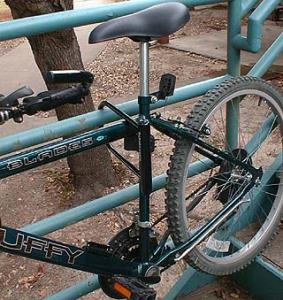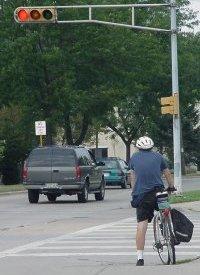- Bicycle Facts
- Accident Causes
- Bicycle Protection and Registration
- Bicycle Selection and Equipment
- Massachusetts Bicycle Laws
- Bicycles on Campus
- Bicycles and Pedestrians
Bicycle Facts

Bicycle usage has steadily increased since the 1950s. The National Safety Council (NSC) estimates that there are about 120 million bikes currently in use in the U.S. This trend continues because of the increased public awareness in keeping physically fit, saving energy, and improving the environment. It is easy to understand that with this increased use, the number of accidents and injuries will also rise.
The Consumer Product Safety Commission (CPSC) estimates that 600,000 people suffer a bicycle related injury requiring emergency room treatment each year. Of these, 140,000 will be face and head trauma.
In 1994, according to the NSC, there were approximately 800 bicycle related deaths and 38,000 non-fatal injuries involving motor vehicles. Almost 70% of these incidents occurred at driveways and intersections with the largest number occurring between the hours of 4PM and 6PM. This will discuss the new ideas in transportation, accident information, choosing and maintaining a bicycle, safety equipment and state regulations applicable to bicycles.
Accident Causes
The NSC estimates that greater than 50% of all bike and motor vehicle collisions at or around intersections are caused by both the driver of the motor vehicle and the cyclist. Mistakes most often made by a cyclist are:
- Failing to yield right of way
- Cycling too fast for conditions
- Disregarding traffic signs and signals
- Cycling against the flow of traffic
- Making an improper turn.
Motorists involved in these accidents usually cited not seeing the cyclist in time to avoid the collision or not seeing the bicycle at all.
Bicycle accidents not involving motor vehicles are usually attributed to falls, loss of control or collisions with people, animals and other objects.
Weather can also play a part in bike related incidents. Ice, rain, sleet and snow dramatically increase your chances of falling. Like cars, bicycles can hydroplane on water. Any situation that reduces the friction (i.e. gravel, railroad tracks, sand, water and wet leaves) between the tires of the bike and the riding surface warrants the rider’s concern.
When you approach any road or surface hazard:
- Reduce your speed
- Avoid wide swerves, quick turns and sudden stops.
To further decrease your chances of being injured on a bicycle, the National Safety Council recommends the four basic principles of safety.
- Control the bicycle.
- Be visible to all other motorists
- Be predictable and obey all traffic laws, signs and signals.
- Wear the appropriate protective equipment, including reflective clothing and helmet.
The only way to teach a child to follow the rules of safe biking is to have parents lead by example.
Give yourself as much space as you need to avoid a potential hazard and allow time to react, if necessary.
Bicycle Protection and Registration
The American Center for Bicycle Registration (ACBR) estimates that more than 15, 000 bicycles are stolen in the United States every day, an increase of 10% over the last five years. On this campus approximately 120 bicycles are reported stolen each year. The largest number of thefts occurs within the first two months of school. The average cost of each bike stolen on this campus is $450.00, with some costing as much as $1,200.00
In order to protect your bicycle from theft, the ACBR, a national computerized bicycle registration program was developed. Used by law enforcement agencies across the country and around the world, the ACBR is recommended by the Amherst College Police. The program allows you to register your bicycle (nationally) at a minimal cost.
Participants receive a certificate that provides legal evidence of ownership and a personalized registration card, which is carried by the bicycle owner. In addition, you would also receive a tamper resistant decal that, when placed on your bike frame would indicate to the local authority that the bike in question is registered with ACBR, through the BikeStar System.
A registration process like the ACBR BikeStar System or the Amherst College Bicycle Registration program, offered at the beginning of school and throughout the year, improve your chances of reclaiming your stolen bicycle. Only 2-5% of all the bikes recovered by law enforcement agencies are returned to their rightful owners. Unless individuals can provide proof of ownership, police departments will auction off or discard recovered bicycles. In either case, the legitimate owner of the bicycle loses.
The Amherst College Police Department would like to recommend the following do’s & don’ts to help you protect your bicycle.
What to Do

- Always lock your bike
- Use (2) “U” or “O” shaped locks
- Cable locks are not recommended
- Identify/mark your bike
- Engrave, tape or paint your name or some other identifying mark on the bike
- Take a picture of the bike
- Place name & address in a plastic bag & set it in the seat post
- Register you bike
- Register your key numbers
- Write down key numbers and lock combinations
- Keep your original receipt of purchase
- Record your model/serial numbers
What not to do
- Lock your bike to a small tree or object
- Lock your bicycle to itself
- Lock your bike in the same place each time
- Locate the bike lock near the ground, where leverage is easily gained for prompt removal
Bicycle Selection and Equipment
Selection of Bicycle
When selecting a bicycle for yourself or someone else there are certain things you must look for in order to provide maximum safety and comfort. All too often, especially for children, parents make the mistake of buying a bike that a child will “grow into,” thinking it will last for several years. An oversized bike is very difficult to drive and control. Increased accidents and injuries will quickly discourage a child, possibly to the point of giving up.
A bicycle must be properly fitted to the operator. You must choose the right size frame and make the necessary adjustments to the handlebars and seat for ease of operation and maximum control.
- To check fit, EH&S suggests seeking advice from an authorized bicycle dealer. The process is:
- Sit on the seat
- Place (1) foot flat on the pedal in the lowest position
- Grasp the handlebars
If you perform the above check, the following should occur:
- Seat height should allow you to touch the pedal in a downward position with your foot parallel to the ground
- With a men’s frame, you should be able to straddle the bike comfortably while standing
- Seat should be parallel to ground
- The upper part of the body should be inclined slightly forward when hands are grasping the handlebar stem, and the stem slightly lower than the seat
- The hands should fall naturally to the handlebar grips w/o stretching
Mandatory and Recommended Bicycle Equipment
Bicycles operated on public roads are required to be fitted with the following equipment:
- Brakes
A braking system that allows the operator to bring the bike to a safe, smooth stop within 30’ on dry, clean, hard level surface from a speed of 15mph. - Headlights
Bicycles driven 30 minutes after sunset to 30 minutes before sunrise must be equipped with a white light lamp visible from a distance of a least 500'. - Rear Lamps/Reflectors
Bicycles operated 30 minutes after sunset to 30 minutes before sunrise must also have either rear facing red lamps or reflectors that are visible from 600' to oncoming headlights of a motor vehicle. - Pedal Reflectors
Bicycles operated from sunset to sunrise must have a reflector on each pedal, or shall have reflective material around each ankle of the operator; they must be visible from 600' to oncoming headlights of a motor vehicle. - Helmets
Any person 12 years of age or under operating a bicycle or being carried, as a passenger on a bicycle on a public way, or bicycle path shall wear a helmet. The helmet must fit the child’s head, and shall be secured by means of straps while the bicycle is being operated. The helmet shall meet the requirements of American National Standards Institute (ANSI), Z90.4 or by the Snell Foundation, 1984, as indicated on the helmet.
Optional / recommended equipment for bicycles might include:
- Rearview mirrors: bicycle or helmet mounted
- Tail or flashing rear lights
- Leg lights or reflectors
- Vests: bright or fluorescent colored
- Rear rack or carrier
- Locks
- Audible device: either a bell or horn is acceptable
Massachusetts Bicycle Laws
In addition to requiring brakes, lights, reflectors and helmets for children 12years of age or less, Massachusetts also requires cyclists to abide by other regulations outlined her from M.G.L., Chapter 85, Sec. 11.
Bicycle operator:
- Shall signal by either hand their intention to stop/turn
- Can ride on a sidewalk for safety reasons, provided they are outside the business district and are not prohibited by local ordinance.
- Must yield to a pedestrian, when passing use bell/horn/voice
- Shall ride single file on any public way
- Shall ride upon a permanent seat
- Shall not transport a person between the ages of 1–4 (or weighing less than 40lbs) on a bicycle, except in a baby seat attached to the bicycle
- Shall not transport a person less than 1 year of age on a bicycle
- Shall give an audible warning when necessary to insure safe operations
- Sirens and whistles are prohibited
- Shall not park a bicycle upon a way or sidewalk in a manner that obstructs vehicle or pedestrian traffic
- Shall keep at least 1 hand on the handlebars shall not carry any article, bundle o r package, except in a basket, rack etc.
- Report any accident involving personal injury or property damage in excess of $100,00, or both, to the police department where incident occurred
- Shall not raise the handlebars so that the hands when gripping are above the level of the shoulders or otherwise alter the bicycle fork from original design or construction
Violations of above regulations, or those identified in the previous column carries a fine of not more than $20.00. If the bike is operated by a person under 18 years of age, the bicycle can be impounded by the police department in that city or town. The parent or guardian of a person 18 years of age or under shall not authorize or knowingly permit any such person to violate the provisions of this section.
Bicycles on Campus

Bicycles on campus can only be placed in designated locations. Racks have been installed across the campus, and the College will distribute additional units as they become available. Please be considerate when you take your bike to class or work.
- Bikes are not permitted in classrooms, corridors and stairwells for safety reasons; they hinder egress and cause injury, especially during an emergency.
- Bikes attached to, or placed on handicapped ramps or handrails make it more difficult for disabled persons to get into and out of buildings
Bicycles left in these areas constitute a violation of state building and fire prevention regulations and are subject to removal by Environmental Health and Safety. If your bicycle is removed it may be reclaimed by contacting the Amherst College Police Department. Should you have questions or concerns, please contact the Amherst College Environmental Health & Safety Department at 542-8189.
Bicycles & Pedestrians
Written by: Rick Mears
May 2017